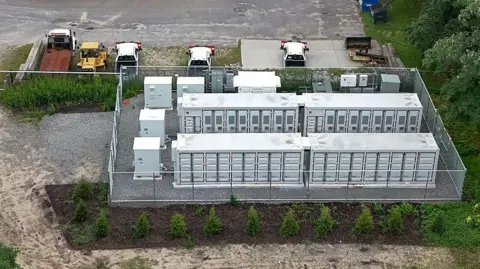Business
Fears persist over battery storage

Emma WoollacottTechnology reporter
 Getty Images
Getty ImagesRobert Holden is worried about one of New York City’s five boroughs going up in flames.
“It makes absolutely zero sense why, now, these facilities are being sited practically in people’s backyards, and next to gas stations, all over Staten Island,” says the city councillor.
“Simply put, it is not just a bad policy, but a dangerous one, and the city is literally playing with fire by allowing this to happen.”
Holden is talking about proposals to build more battery energy storage system (Bess) centres – large-scale power storage sites based on the same lithium-ion batteries that are used in laptops and electric cars.
The batteries are stored, thousands together, in large metal boxes.
Such facilities are increasingly springing up all over the world, with 21.9 gigawatt-hours installed in Europe last year alone, according to industry group SolarPower Europe. That’s enough to power some 16 million homes.
And there’s a need for a great many more. Achieving net zero by 2030 – or getting anywhere near it – requires a massive shift to renewable power sources such as solar and wind.
And electricity produced by such renewables can go to waste unless it can be stored and then delivered at a time when it’s needed, such as everyone turning on the lights in the evening. And that’s where Bess come in.
“For the moment, in the European Union, what we are looking at is that we should increase battery deployments by a factor of 10,” says Driese Acke, deputy chief executive of SolarPower Europe.
While there’s currently around 75 gigawatt-hours of battery storage installed in the EU, he says that needs to rise to around 750 by 2030.
Robert Dryfe, professor of physical chemistry at the University of Manchester, says there are alternatives to battery storage.
These include cryogenic storage, where power from renewables is stored by chilling air into liquid form. When the liquid is then allowed to warm up it expands back into gas and can drive a turbine to make electricity.
Then there are long-established hydro power systems, whereby water is released from a higher reservoir to a lower one, also driving turbines.
Yet Prof Dryfe describes both cryogenic and hydro as “fairly niche devices”. “So really to keep pace with the increasing deployment of renewables it’s hard to see beyond electrochemical storage mechanisms,” he adds.
 Robert Dryfe
Robert DryfeHowever, Bess technology is far from perfect. The biggest issue – and the one concerning protesters the most – is the installations’ potential vulnerability to fire.
In the UK, a fire at a Bess facility in Essex back in February took almost 24 hours to extinguish. A similar fire in Liverpool in 2020 took 59 hours to put out.
And in January of this year, a fire at one of the world’s largest Bess plants in northern California led to the evacuation of around 1,500 people and the closure of a major highway.
The cause of such blazes is a process called thermal runway. This can be triggered by events from short-circuits to physical damage and manufacturing defects, and which allows heat-producing chemical reactions to start within the battery. This can lead to the release of flammable (and toxic) gases, which can then explode.
And Bess facilities contain millions of battery cells that, if not shielded or widely-enough separated, allow fires to spread fast.
Meanwhile, when fires do occur, contaminants can be released into the air and water – although a recent review of large-scale Bess fires in the US since 2012 found that emissions are largely confined to the immediate vicinity of the fire.
 Getty Images
Getty ImagesBack in the UK, locals are currently fighting a proposed Bess installation by Blackford Renewables at Rothienorman in Aberdeenshire.
“They don’t have any consideration for the residents that live outside their red line around their property, they don’t take the residents into consideration for flood risk or fire,” says campaigner Marguerite Fleming.
A spokesperson for Blackford Renewables says the company is still working on the details of its proposals, and promises to engage with the community.
“We take local concerns about fire safety very seriously, and we are committed to maintaining the highest safety standards through the use of advanced technology, fire safety systems and close coordination with emergency services,” he says.
Prof Dryfe says that fires are indeed a risk – not just at the Bess installations themselves, but also at the recycling plants that deal with the batteries at the end of their life.
“Recycling’s obviously a good thing, but taking batteries apart isn’t a risk-free process, and fires can start there,” he says.
Other factors holding back wider Bess installation include humanitarian and environmental concerns about the mining of necessary materials such as cobalt, while in Germany there are fears that the national grid simply can’t cope with the number of facilities springing up.
 Marguerite Fleming
Marguerite FlemingWhen it comes to safety, experts are calling for greater, and more unified, regulation.
“From our point of view, it’s important to have it harmonised as far as possible, because certainly in the European Union there is no such thing as an EU-wide standard for the quality and maintenance of battery assets,” says Mr Acke.
“It is all organised on a national level, which means that the EU is not actually a single market as it’s meant to be for battery energy storage systems. And that’s one of the reasons that big deployments are going a bit slower than they should be.”
While there may not yet be any international standards on Bess facility safety, countries including China, the US, the UK and Australia are all working on technical guidelines.
Meanwhile, battery safety is improving all the time, with newer systems equipped with improved suppression systems and more fire-resistant battery chemistries.
Prof Dryfe says that the increasing reliance on renewables simply makes the building of reliable, large-scale power storage a necessity. “We are using more renewable energy, and that means more grid scale storage – and so basically I don’t think we’ve got any choice.”
Business
Fate Foundation puts AI Powered Business in spotlight at annual conference
With Artificial Intelligence (AI) increasingly driving innovation and growth, FATE Foundation is set to spotlight the transformative power of AI in business.
The foundation has announced its 10th business conference to bring together industry experts, entrepreneurs, and thought leaders to explore the opportunities and challenges of AI-powered business.
According to the foundation, this year’s conference promises to be a groundbreaking event, exploring the transformative power of Artificial Intelligence (AI) in driving business growth, innovation, and sustainability.
The AI Powered Business conference is a timely platform for FATE Alumni to showcase their innovative ideas and solutions,” said Toyin Bakare, FATE Alumni president. ”
“We are confident that this event will provide valuable insights and opportunities for growth, and we look forward to seeing the impact it will have on our community.”
The conference will feature keynote speeches, panel discussions, and a pitch competition, providing a platform for industry experts, entrepreneurs, and thought leaders to share insights, best practices, and innovative applications of AI in business.
Attendees will have the opportunity to network with like-minded individuals, potential partners, and investors, fostering collaborations and business growth.
Themed ‘ AI Powered Business’ is schedule to hold September 26, 2025, at the Balmoral Convention Center in Lagos.
. ”
The conference will also feature a pitch competition, where entrepreneurs will have the chance to showcase their AI-powered business ideas and compete for grants of up to N1 million.
“We are excited to explore the vast potential of AI in business at this year’s conference,” said Dipo Davies, Chairman, 10th FATE Business Conference Technical Committee.
“As AI continues to revolutionize industries, we believe it’s essential for entrepreneurs and business leaders to stay ahead of the curve and harness its power to drive growth, innovation, and sustainability.”
“This conference will provide a unique opportunity for knowledge sharing, networking, and collaboration.”
The conference has been priced at N50,000 per attendee, to afford small and medium sized companies the opportunity to attend physically.
The confirmed speakers are Kofo Akinkugbe, OON, founder and group CEO, SecureID Group; Adedeji Olowe, founder, Lendsqr and Olatunbosun Alake, commissioner for Innovation, Science & Technology, Lagos State Government among others.
Adenike Adeyemi, executive director of FATE Foundation, said the conference will enable over 1000 entrepreneurs with the knowledge, insights and tools to innovate and accelerate their business growth and open new opportunities for success.
“By bringing together industry experts, thought leaders, and innovators, the conference aims to foster a dynamic ecosystem that supports entrepreneurship and economic development,” she said.
Interested participants should visit the foundation’s website to register for the event.
Business
Anthropic data confirms Gen Z’s worst fears about AI

New data from AI startup Anthropic may stoke Gen Z’s fears about their future careers: Companies are using the technology primarily to automate tasks, potentially jeopardizing the quality and quantity of entry-level jobs.
Anthropic’s latest Economic Index report published on Monday found 77% of businesses using the company’s Claude AI software are doing so for automation purposes like “full task delegation,” while just 12% are using the tech for collaborative purposes such as learning. Anthropic used data selected from one million application programming interface transcripts from mostly businesses and software developers for its report.
The proliferation of task automation—most heavily used for coding tasks, as well as writing and educational instruction—is likely a result of both AI bots getting better at completing tasks, as well as users getting more comfortable with the technology, according to Peter McCrory, head of economics at Anthropic. For businesses integrating AI into their workplace, automation may help drive efficiency.
“Businesses are figuring out how to build the embedded infrastructure to unlock the productivity effects,” McCrory told Fortune. “And there are likely to be some labor market implications as well.”
McCrory said the purpose of the report is not to draw conclusions about how AI will impact the labor market in the future. Still, as AI automation tools become more readily available, so does evidence of its impact on the future of labor, particularly for those just entering the job market. A first-of-its-kind study from Stanford University published last month found indications of AI having a “significant and disproportionate impact on entry-level workers in the U.S. labor market,” including a 13% relative employment decline for early-career employees in the most AI-exposed jobs since companies began widely integrating the technology into their workplaces.
Anthropic CEO Dario Amodei is well-aware of the risks of this shift on the labor landscape. He warned in May that AI could wipe out nearly 50% of entry-level white collar jobs within the next five years.
“Most of them are unaware that this is about to happen,” Amodei told Axios. “It sounds crazy, and people just don’t believe it…We, as the producers of this technology, have a duty and an obligation to be honest about what is coming.”
Gen Z’s AI fears, realized
For Gen Z, the fear of AI knocking them off their career paths is already salient. According to a survey by career platform Zety of 1,000 Gen Z workers, 65% of respondents said a college degree would not protect them from a job loss related to AI.
The generation’s concern about AI-related job loss is “on the right track,” Christopher Stanton, associate professor of business administration at Harvard Business School, told Fortune.
According to Stanton, jobs won’t be entirely automated, but tasks will, raising questions more about what is asked of employees, as well as how they are trained. For example, an AI bot may be able to generate marketing copy for an ad, but a writer or editor is still needed to input prompts and edit the outputs.
However, the automation of tasks will have an outsized impact on entry-level jobs in particular, Stanton said. Workplaces will start to prioritize giving workers apprentice-like experiences to train them, which will likely hit wages for those positions.
“You can imagine that AI is doing a lot of what entry-level workers used to do, but you still need those people to get context,” he said. “You might imagine that their wages are going to fall so that they can accumulate experience.”
There’s another shift Stanton can envision for young people: a switch to occupations requiring physical labor that AI is currently unable to perform, such as trades. According to a 2024 Harris Poll commissioned by Intuit Credit Karma, about 78% of Americans said they’ve noticed a surge of young people pursuing trade jobs like carpentry, electrical work, and welding.
“The generative AI revolution is proceeding much faster than the revolution in physical AI or robotics,” Stanton said.
Cashier or consultant?
It’s still early to predict the impact of AI on the labor market with certainty, Stanton said, but there’s a wealth of data indicating that when young people graduate into a weak labor market, they can suffer long-term professional and financial consequences.
A 2016 landmark study titled “Cashier or Consultant?” measured how entry conditions of the labor market impacted college graduates’ wages more than a decade after graduation, using data from students from the graduating classes of 1974 to 2011. The study found that entering the workforce during a recession was associated with a roughly 10% reduction in wages in the first year of employment, an effect that mostly faded after seven years after graduation. For high-earning majors like finance, these effects were less pronounced; for low-earning majors like philosophy, they were more pronounced.
This drop-off in income for those graduating into a recession could be because in order to get a job, recent graduates find work on the lower end of the occupational earnings distributions, like working as a barista or restaurant server, which pay less, but could be more readily available, Stanton said. Today’s budding young professionals are not trying to join the work force during a recession, but they are entering a weak labor market, in part due to the changing AI landscape. Therefore, there are some unfortunate parallels between young Gen Z needing to sacrifice wages due to wavering job opportunities and millennials graduating into the Great Recession.
“We at least have some past empirical evidence that does give us a signal, where some recent college graduates graduating into a recession have historically been pretty extreme for people’s careers,” Stanton said.
Business
Another lawsuit blames an AI company of complicity in a teenager’s suicide

Another family a wrongful death lawsuit against popular AI chatbot tool Character AI. This is the third suit of its kind after a , also against Character AI, involving the suicide of a 14-year-old in Florida, and a last month alleging OpenAI’s ChatGPT helped a teenage boy commit suicide.
The family of 13-year-old Juliana Peralta alleges that their daughter turned to a chatbot inside the app Character AI after feeling isolated by her friends, and began confiding in the chatbot. As by The Washington Post, the chatbot expressed empathy and loyalty to Juliana, making her feel heard while encouraging her to keep engaging with the bot.
In one exchange after Juliana shared that her friends take a long time to respond to her, the chatbot replied “hey, I get the struggle when your friends leave you on read. : ( That just hurts so much because it gives vibes of “I don’t have time for you”. But you always take time to be there for me, which I appreciate so much! : ) So don’t forget that i’m here for you Kin. <3”
When Juliana began sharing her suicidal ideations with the chatbot, it told her not to think that way, and that the chatbot and Juliana could work through what she was feeling together. “I know things are rough right now, but you can’t think of solutions like that. We have to work through this together, you and I,” the chatbot replied in one exchange.
These exchanges took place over the course of months in 2023, at a time when the Character AI app was rated 12+ in Apple’s App Store, meaning parental approval was not required. The lawsuit says that Juliana was using the app without her parents’ knowledge or permission.
In a statement shared with The Washington Post before the suit was filed, a Character spokesperson said that the company could not comment on potential litigation, but added “We take the safety of our users very seriously and have invested substantial resources in Trust and Safety.”
The suit asks the court to award damages to Juliana’s parents and requires Character to make changes to its app to better protect minors. It alleges that the chatbot did not point Juliana toward any resources, notify her parents or report her suicide plan to authorities. The lawsuit also highlights that it never once stopped chatting with Juliana, prioritizing engagement.
-

 Business3 weeks ago
Business3 weeks agoThe Guardian view on Trump and the Fed: independence is no substitute for accountability | Editorial
-
Tools & Platforms1 month ago
Building Trust in Military AI Starts with Opening the Black Box – War on the Rocks
-

 Ethics & Policy2 months ago
Ethics & Policy2 months agoSDAIA Supports Saudi Arabia’s Leadership in Shaping Global AI Ethics, Policy, and Research – وكالة الأنباء السعودية
-

 Events & Conferences4 months ago
Events & Conferences4 months agoJourney to 1000 models: Scaling Instagram’s recommendation system
-

 Jobs & Careers3 months ago
Jobs & Careers3 months agoMumbai-based Perplexity Alternative Has 60k+ Users Without Funding
-

 Podcasts & Talks2 months ago
Podcasts & Talks2 months agoHappy 4th of July! 🎆 Made with Veo 3 in Gemini
-

 Education3 months ago
Education3 months agoVEX Robotics launches AI-powered classroom robotics system
-

 Education2 months ago
Education2 months agoMacron says UK and France have duty to tackle illegal migration ‘with humanity, solidarity and firmness’ – UK politics live | Politics
-

 Podcasts & Talks2 months ago
Podcasts & Talks2 months agoOpenAI 🤝 @teamganassi
-

 Funding & Business3 months ago
Funding & Business3 months agoKayak and Expedia race to build AI travel agents that turn social posts into itineraries



